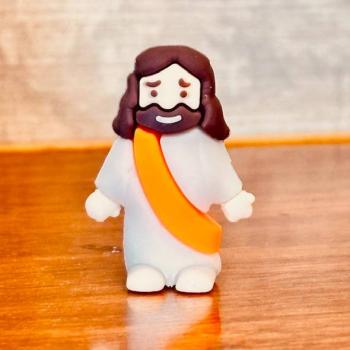Divine Dialogue—Prayer Between God and Us, and the Wesleyan Vision of Piety
Exploring Luke 11:1-13 and John 17:20-23 Through the Lens of John Wesley
The following is a message I am giving in a few weeks as I begin to step back into the pulpit. This has been a long time coming and there is a lot of uncertainty around how I will be received. I have been told that the church is ready for me. I am many years away from that 25-year-old that first stepped in the pulpit, and it has been seven years since I last gave a public address. This week for my first post, I want to visit a familiar topic, prayer.
The Mystery and Gift of Prayer
Prayer is the way I live, the way we must live. My wife stole me from the monastery (briefly tell the story). Early in my life, I was tasked to pray the hours, go to mass daily and in general, live a life of prayer. From those early Hail Mary’s and praying the hours on a strict schedule to now praying as the moment arises, prayer has been a constant in my life since I was fifteen.
The question then is “Why do we Pray?”
Prayer serves many roles in people’s lives. As a therapist, I believe in a lot of ways it becomes a form of perceived control when things are uncontrollable, say in the instance of a major illness, imminent death or some other tragedy.
While prayer can often be seen as a refuge in times of despair, it also serves as a constant companion and a means to cultivate a deeper spiritual connection, enriching one’s life beyond moments of crisis. In my experience, prayer has grown from a series of recitations to an ongoing, dynamic conversation with the divine. Whether in moments of joy or sorrow, prayer offers an avenue to express one’s innermost thoughts and emotions. It is through this personal engagement that prayer transcends its traditional boundaries, becoming a profound dialogue that nurtures the soul and fosters resilience. Exploring the myriad forms of prayer, such as adoration, confession, thanksgiving, and intercession, allows us to embrace the full spectrum of communication with God and to deepen our spiritual voyage. This evolution in understanding not only enhances our relationship with the divine but also transforms our approach to life’s challenges, offering solace, guidance, and inspiration.
Luke 11:1-13—Our Prayer to God: Learning from Jesus
- The Disciples’ Request
The Jewish temple system was complex, with several competing parties including the Pharisees and the Sadducees. Today like in Jesus’ time, prayer can be very daunting, especially when asked to do it in public. I remember all my girls at some point or another being asked for the first time to pray in public. The Disciples come to Jesus and ask him how to pray, and Jesus’ instruction is that we come to prayer with a sense of humility. We pray in secret, emphasizing a personal connection with God rather than seeking public recognition. He provides us a model for prayer, often referred to as the Lord’s Prayer, which includes elements of praise, petition, and forgiveness.
- The Lord’s Prayer—Content and Posture
The prayer we traditionally call the Lord’s prayer, is rich in cultural significance that would’ve had deep meaning for Jesus and his followers.
The society in which Jesus lived was patriarchal, as reflected in the language of that period. One topic discussed is the personal nature of Jesus’ prayer when he refers to God as Abba. During this era, concepts such as kingdom building were prominent aspects of daily life. In some instances, Jesus presented perspectives that differed from prevailing social norms, which occasionally led to conflict with the authorities. When Jesus asked God to deliver him and his Jewish followers from evil, this had a very significant cultural context to it. Evil was all around them through the subversive acts of the Roman occupation as well as the normal diseases and stressors that came with dessert life. With this understanding, we can gain a richer understanding of the significance of the Lord’s prayer.
Examining the Lord’s prayer, we find several themes:
- The recognition of God’s holiness: “Father, hallowed be your name.” – this emphasis is squarely rooted in Jesus’ Judaism. YHWH, such a holy name that it is not even uttered out loud by our Jewish cousins. As Moses took his sandals off in God’s presence, so we too must approach God humbly.
- Submission to God’s reign: “Your kingdom come.” – this reign is not a human reign; it is a recognition of God’s sovereignty. God and humankind engage in a divine balance. God is loving, but not coercive. God acts independently of our intentions and desires. When we submit to God’s timing, we are submitting to God’s sovereignty.
- Dependence for daily needs: “Give us each day our daily bread.” – here we are talking about providence. God gives us just enough, in the divine dance of constant engagement with God, rooted in prayer, we become more attuned to this divine presence.
- Request for forgiveness and grace to forgive: “Forgive us our sins, for we also forgive…” – here, a foreshadowing of the forgiveness that Jesus offers on the cross. God is a God of love and grace. Grace, something John Wesley focused heavily in his work in the Methodist tradition is a cornerstone of our belief system. We must go and do likewise.
- Guidance and deliverance: “Lead us not into temptation.” – It is our reliance on the Holy Spirit to guide our steps. In a constant attitude of prayer and mindfulness of the Holy Spirit’s direction, we take paths that builds God’s kindom here and thus, become instruments of peace.
This is prayer as inner piety: an orientation of the heart toward God, grounded in trust, humility, and surrender. Wesley emphasized that true piety is first a matter of the heart; all outward acts must spring from inward transformation. Benedict challenges us to listen with the ears of our heart, this can only be accomplished when we begin with and live continually in prayer.
John 17:20-23—God’s Prayer for Us: The Heart of Unity
- Jesus Prays for His Disciples—and for Us
While we are praying to God, God is not quietly sitting by and taking it all in. God is active with us in our prayers. In John 17, we overhear Jesus praying not just for the first disciples, but for “those who will believe in me through their word”—that is, us. Christ is with us continually in our dialogue.
Jesus’ prayer includes several supplications, all of which point us to the need for unity, something that we as Christians need to be reminded of in our fractured Christian and Secular world:
Jesus’ desire: “That they may all be one, just as you, Father, are in me, and I in you.”
This unity of believers reflects the Trinity, which serves as a model for the unity God calls us to embody daily, beyond just theological doctrine.
Reflecting on Wesley, he taught that faith and love toward God must be expressed in love toward neighbor. The unity Jesus prays for is not unity of opinion, but unity of spirit and mission, manifest in holy living.
Wesley of course looks at inwardly and outwardly,
- Inner piety: Union with God—cultivating a heart united with Christ and with one another.
- Outer piety: The visible witness of love, mercy, and unity within the Church—so that the world may know God’s love.
Most people engage in what is known as petitionary prayer. Petitionary prayer refers to a form of prayer where individuals request specific outcomes, such as healing, guidance, or support during challenging circumstances. This type of prayer involves making direct requests, often expressing a dependence on external assistance. There are many other types of prayer. Consider these alternatives:
- Adoration: Praising God for who He is and His attributes. I have had countless moments of these very short prayers of praise whether it is sunsets or small client victories, thanking God for God’s present in the moment brings me closer to God.
- Confession: Honestly acknowledging our sins and shortcomings.
- Thanksgiving: Expressing gratitude for blessings, both big and small.
- Intercession: Praying for others – family, friends, community, leaders, and even enemies.
- Pray for Spiritual Growth: Ask God for deeper faith, wisdom, discernment, courage, and a greater understanding of God’s will.
- Pray Scripture: Use Bible verses as a foundation for your prayers. Praying Scripture back to God can deepen your understanding and align your heart with God’s Word. My favorite coffee mug has Psalm 23 on it. I read it every morning as reminder of God’s providence.
Through practices of lectio divina and centering prayer, we deepen our experience of scripture and focus on God’s presence in our lives. When we pray in silence we are spending time in stillness, listening for God’s quiet voice. talk about the use of May at be so versus amen.
Other practices we can engage in are journaling your prayers. In a posture of prayer, I started a practice of weekly blogging when I realized how much I missed the process of writing sermons weekly and in a way became my journal of my lectio and moving meditations. Finally, we can engage our senses by turning off our music, turning off all distractions and allowing our five senses to notice God’s reverberance in our daily life. When we truly cultivate a listening heart, we will hear the presence of God.
In Closing: Living the Divine Dialogue
Prayer is the heartbeat of the Christian life. In the rhythm of our prayers to God and God’s prayers for us, we are drawn into the life of the Triune God and sent as witnesses to the world. Let us, like the disciples, ask Christ to teach us to pray, and like the early Methodists, let us pursue holiness of heart and life, not for our own sake alone, but so that the world may know the love of God made manifest in Christ Jesus our Lord. We must let our prayer life mature as we mature.
Prayer for me, has always been a way to find solace and guidance. It is a practice that brings a sense of peace amidst the chaos of daily life, a way to center myself and remember what is truly important. Whether it is a quick, silent prayer during a hectic day or a longer, more meditative session in a quiet moment, each prayer is a chance to reconnect with my faith and find clarity and strength.
Finally, as you go about your week, I challenge you to take a moment to pause and pray. Let it be a moment of reflection, gratitude, and connection. Let it be a time to find peace and strength, and to remember that you are never alone on this journey of faith.













